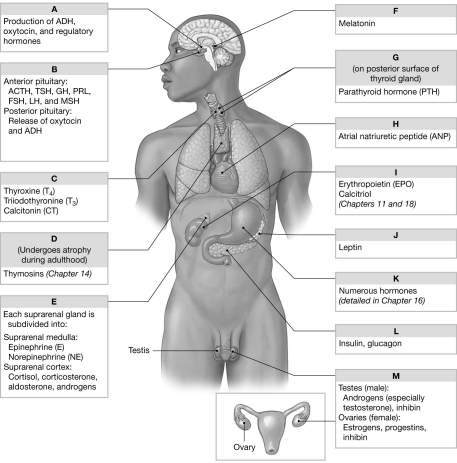A) estrogen.
B) progesterone.
C) testosterone.
D) inhibin.
E) both C and D
Correct Answer

verified
Correct Answer
verified
Multiple Choice
Diabetes insipidus is caused by
A) decreased levels of insulin.
B) decreased numbers of insulin receptors.
C) decreased levels of ADH.
D) decreased numbers of ADH receptors.
E) none of the above
Correct Answer

verified
Correct Answer
verified
Multiple Choice
The hormone oxytocin
A) promotes uterine contractions.
B) is responsible for milk production in the mammary glands.
C) regulates blood pressure.
D) governs the ovarian cycle.
E) both A and B
Correct Answer

verified
Correct Answer
verified
Multiple Choice
The pituitary hormone that stimulates increases in bone and muscle mass is
A) TSH.
B) ACTH.
C) MSH.
D) LH.
E) GH.
Correct Answer

verified
Correct Answer
verified
Short Answer
Sometimes a releasing hormone is required for release of another hormone. This property is called _________________________.
Correct Answer

verified
Correct Answer
verified
Multiple Choice
Hormones from which of the following glands are responsible for the calorigenic effect?
A) pituitary gland
B) suprarenal gland
C) parathyroid gland
D) thyroid gland
E) thymus
Correct Answer

verified
Correct Answer
verified
Multiple Choice
Decreased blood flow to the kidneys would lead to
A) renin release.
B) elevated levels of aldosterone.
C) increased levels of erythropoietin.
D) decreased levels of atrial natriuretic peptide.
E) all of the above
Correct Answer

verified
Correct Answer
verified
Short Answer
 Using the figure above, identify the labeled part.
-Label H: ________
Using the figure above, identify the labeled part.
-Label H: ________
Correct Answer

verified
Correct Answer
verified
Multiple Choice
This condition is characterized by excessive lengthening of bones.
A) diabetes mellitus
B) acromegaly
C) glucose diabetes
D) gigantism
E) all of the above
Correct Answer

verified
Correct Answer
verified
Short Answer
The basic pattern of response that the body produces in response to stress is called the _________________________.
Correct Answer

verified
general ad...View Answer
Show Answer
Correct Answer
verified
View Answer
Multiple Choice
The alpha cells of the pancreas produce
A) insulin.
B) glucagon.
C) rennin.
D) ADH.
E) parathyroid hormone.
Correct Answer

verified
Correct Answer
verified
Multiple Choice
The hormone that dominates during the alarm phase of the general adaptation syndrome (GAS) is
A) testosterone.
B) aldosterone.
C) cortisol.
D) thyroid hormone.
E) epinephrine.
Correct Answer

verified
Correct Answer
verified
Multiple Choice
During the alarm phase of the general adaptation syndrome (GAS) , there is
A) decreased blood flow to skeletal muscles and skin.
B) decreased mental alertness.
C) mobilization of energy reserves.
D) increased urine production.
E) all of the above
Correct Answer

verified
Correct Answer
verified
Short Answer
 Using the figure above, identify the labeled part.
-Label K: ________
Using the figure above, identify the labeled part.
-Label K: ________
Correct Answer

verified
Correct Answer
verified
Multiple Choice
When a protein or peptide hormone binds to receptors on the surface of a cell,
A) the hormone receptor complex moves into the cytoplasm.
B) the plasma membrane becomes depolarized.
C) a second messenger appears in the cytoplasm.
D) the cell becomes inactive.
E) the hormone is transported to the nucleus, where it alters the activity of the DNA.
Correct Answer

verified
Correct Answer
verified
Multiple Choice
Hypothalamic signals reach the anterior pituitary through the
A) infundibulum.
B) hypophyseal portal system.
C) hypothalamus.
D) hypophysis.
E) thymus.
Correct Answer

verified
Correct Answer
verified
Multiple Choice
The most complex endocrine responses involve the
A) thyroid gland.
B) pancreas.
C) suprarenal glands.
D) hypothalamus.
E) thymus.
Correct Answer

verified
Correct Answer
verified
Multiple Choice
Hormone concentration levels are most commonly controlled by
A) positive feedback.
B) the quantity of circulating hormone.
C) negative feedback.
D) cellular demands.
E) body temperature.
Correct Answer

verified
Correct Answer
verified
Multiple Choice
Excessive urine production is known as
A) polyphagia.
B) polydipsia.
C) polyuria.
D) polymyositis.
E) none of the above
Correct Answer

verified
Correct Answer
verified
Multiple Choice
This condition develops when the posterior pituitary no longer releases adequate amounts of ADH.
A) diabetes mellitus
B) diabetes insipidus
C) pituitary dwarfism
D) exophthalmos
E) gigantism
Correct Answer

verified
Correct Answer
verified
Showing 21 - 40 of 100
Related Exams